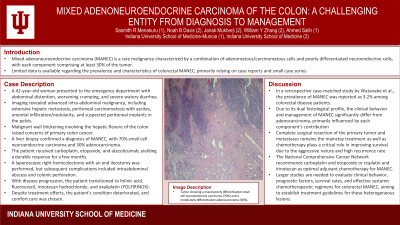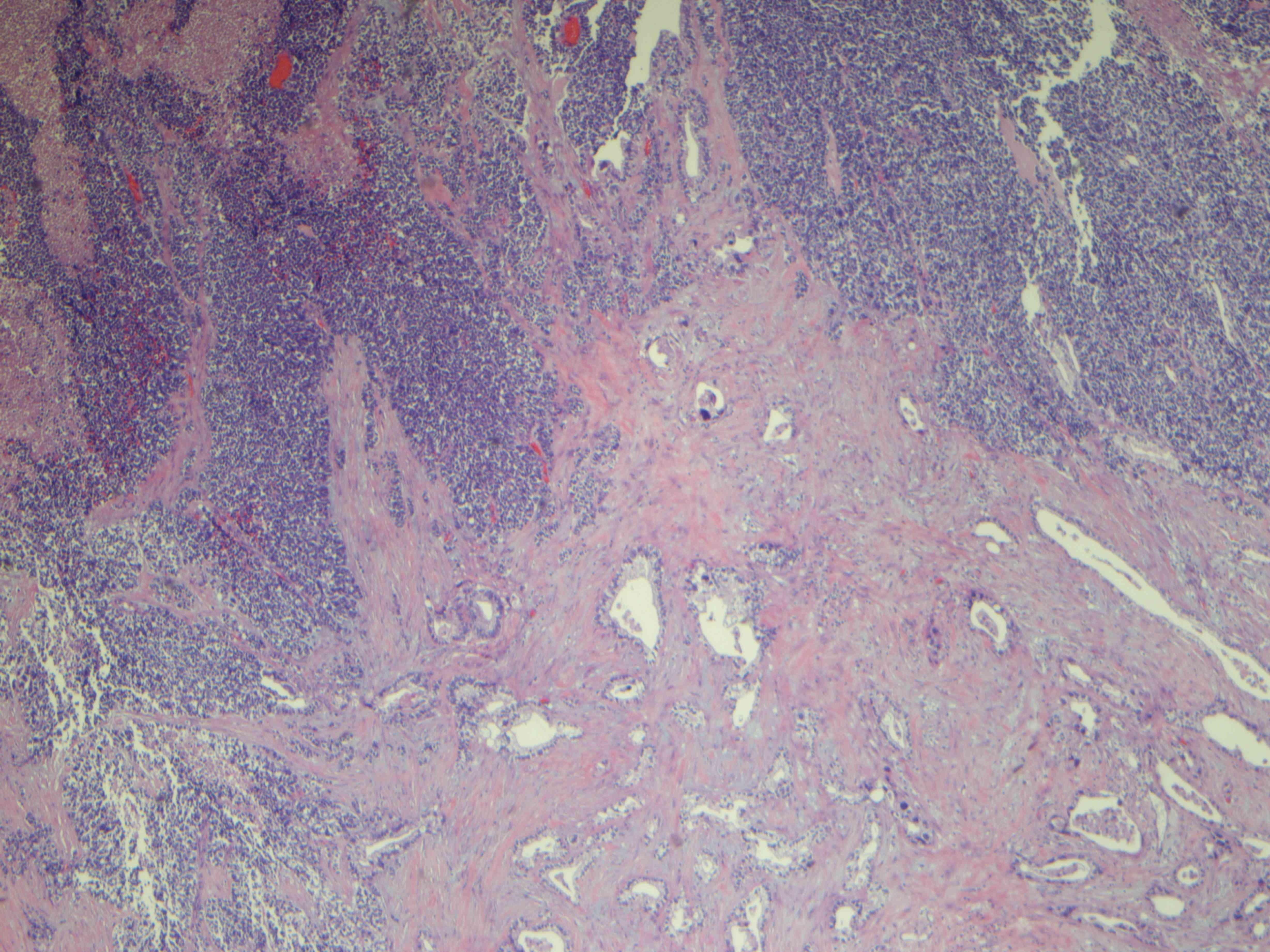Tuesday Poster Session
Category: Colon
P3114 - Mixed Adenoneuroendocrine Carcinoma of the Colon: A Challenging Entity From Diagnosis to Management
Tuesday, October 24, 2023
10:30 AM - 4:00 PM PT
Location: Exhibit Hall

Has Audio
- SM
Sasmith Menakuru, MD
Indiana University School of Medicine
Muncie, Indiana
Presenting Author(s)
Award: Presidential Poster Award
Sasmith Menakuru, MD1, Noah B. Davis, MD2, Janak Mukherji, MD2, William Y. Zhang, MD2, Ahmed Salih, MD1
1Indiana University School of Medicine, Muncie, IN; 2Indiana University School of Medicine, Indianapolis, IN
Introduction: Mixed adenoneuroendocrine carcinoma (MANEC) is a rare malignancy characterized by a combination of adenomatous/carcinomatous cells and poorly differentiated neuroendocrine cells, with each component comprising at least 30% of the tumor. Limited data is available regarding the prevalence and characteristics of colorectal MANEC, primarily relying on case reports and small case series.
Case Description/Methods: A 42-year-old woman presented to the emergency department with abdominal distention, worsening cramping, and severe watery diarrhea. Imaging revealed advanced intra-abdominal malignancy, including extensive hepatic metastasis, peritoneal carcinomatosis with ascites, omental infiltration/nodularity, and suspected peritoneal implants in the pelvis. Malignant wall thickening involving the hepatic flexure of the colon raised concerns of primary colon cancer. A liver biopsy confirmed a diagnosis of MANEC, with 70% small cell neuroendocrine carcinoma and 30% adenocarcinoma. The patient received carboplatin, etoposide, and atezolizumab, yielding a durable response for a few months. A laparoscopic right hemicolectomy with an end ileostomy was performed, but subsequent complications included intraabdominal abscess and colonic perforation. With disease progression, the patient transitioned to folinic acid, fluorouracil, irinotecan hydrochloride, and oxaliplatin (FOLFIRINOX). Despite treatment efforts, the patient's condition deteriorated, and comfort care was chosen.
Discussion: In a retrospective case-matched study by Watanabe et al., the prevalence of MANEC was reported as 3.2% among colorectal disease patients. Due to its dual histological profile, the clinical behavior and management of MANEC significantly differ from adenocarcinoma, primarily influenced by each component's contribution and the neuroendocrine cell type. Complete surgical resection of the primary tumor and metastases remains the mainstay treatment. Adjuvant chemotherapy plays a critical role in improving survival due to the aggressive nature and high recurrence rate of MANEC. The National Comprehensive Cancer Network recommends carboplatin and etoposide or cisplatin and irinotecan as optimal adjuvant chemotherapy for MANEC. Larger studies are needed to evaluate clinical behavior, prognostic factors, survival rates, and effective systemic chemotherapeutic regimens for colorectal MANEC, aiming to establish treatment guidelines for these heterogeneous lesions.

Disclosures:
Sasmith Menakuru, MD1, Noah B. Davis, MD2, Janak Mukherji, MD2, William Y. Zhang, MD2, Ahmed Salih, MD1. P3114 - Mixed Adenoneuroendocrine Carcinoma of the Colon: A Challenging Entity From Diagnosis to Management, ACG 2023 Annual Scientific Meeting Abstracts. Vancouver, BC, Canada: American College of Gastroenterology.
Sasmith Menakuru, MD1, Noah B. Davis, MD2, Janak Mukherji, MD2, William Y. Zhang, MD2, Ahmed Salih, MD1
1Indiana University School of Medicine, Muncie, IN; 2Indiana University School of Medicine, Indianapolis, IN
Introduction: Mixed adenoneuroendocrine carcinoma (MANEC) is a rare malignancy characterized by a combination of adenomatous/carcinomatous cells and poorly differentiated neuroendocrine cells, with each component comprising at least 30% of the tumor. Limited data is available regarding the prevalence and characteristics of colorectal MANEC, primarily relying on case reports and small case series.
Case Description/Methods: A 42-year-old woman presented to the emergency department with abdominal distention, worsening cramping, and severe watery diarrhea. Imaging revealed advanced intra-abdominal malignancy, including extensive hepatic metastasis, peritoneal carcinomatosis with ascites, omental infiltration/nodularity, and suspected peritoneal implants in the pelvis. Malignant wall thickening involving the hepatic flexure of the colon raised concerns of primary colon cancer. A liver biopsy confirmed a diagnosis of MANEC, with 70% small cell neuroendocrine carcinoma and 30% adenocarcinoma. The patient received carboplatin, etoposide, and atezolizumab, yielding a durable response for a few months. A laparoscopic right hemicolectomy with an end ileostomy was performed, but subsequent complications included intraabdominal abscess and colonic perforation. With disease progression, the patient transitioned to folinic acid, fluorouracil, irinotecan hydrochloride, and oxaliplatin (FOLFIRINOX). Despite treatment efforts, the patient's condition deteriorated, and comfort care was chosen.
Discussion: In a retrospective case-matched study by Watanabe et al., the prevalence of MANEC was reported as 3.2% among colorectal disease patients. Due to its dual histological profile, the clinical behavior and management of MANEC significantly differ from adenocarcinoma, primarily influenced by each component's contribution and the neuroendocrine cell type. Complete surgical resection of the primary tumor and metastases remains the mainstay treatment. Adjuvant chemotherapy plays a critical role in improving survival due to the aggressive nature and high recurrence rate of MANEC. The National Comprehensive Cancer Network recommends carboplatin and etoposide or cisplatin and irinotecan as optimal adjuvant chemotherapy for MANEC. Larger studies are needed to evaluate clinical behavior, prognostic factors, survival rates, and effective systemic chemotherapeutic regimens for colorectal MANEC, aiming to establish treatment guidelines for these heterogeneous lesions.

Figure: Tumor showing a mixed poorly differentiated small cell neuroendocrine carcinoma (70%) and a moderately differentiated adenocarcinoma (30%).
Disclosures:
Sasmith Menakuru indicated no relevant financial relationships.
Noah B. Davis indicated no relevant financial relationships.
Janak Mukherji indicated no relevant financial relationships.
William Y. Zhang indicated no relevant financial relationships.
Ahmed Salih indicated no relevant financial relationships.
Sasmith Menakuru, MD1, Noah B. Davis, MD2, Janak Mukherji, MD2, William Y. Zhang, MD2, Ahmed Salih, MD1. P3114 - Mixed Adenoneuroendocrine Carcinoma of the Colon: A Challenging Entity From Diagnosis to Management, ACG 2023 Annual Scientific Meeting Abstracts. Vancouver, BC, Canada: American College of Gastroenterology.

